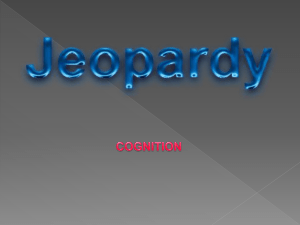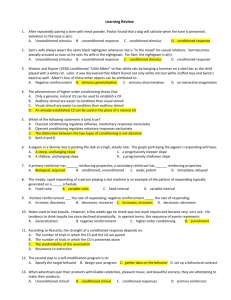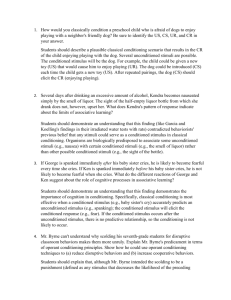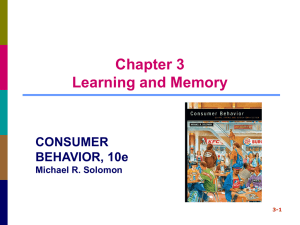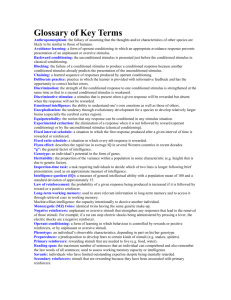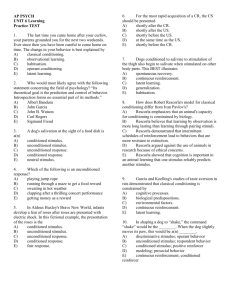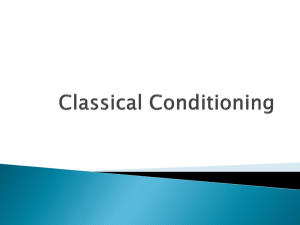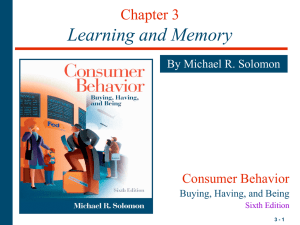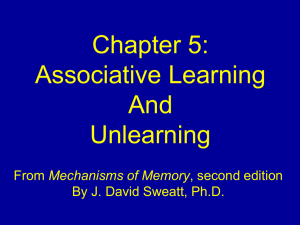Psychology Unit Four
advertisement
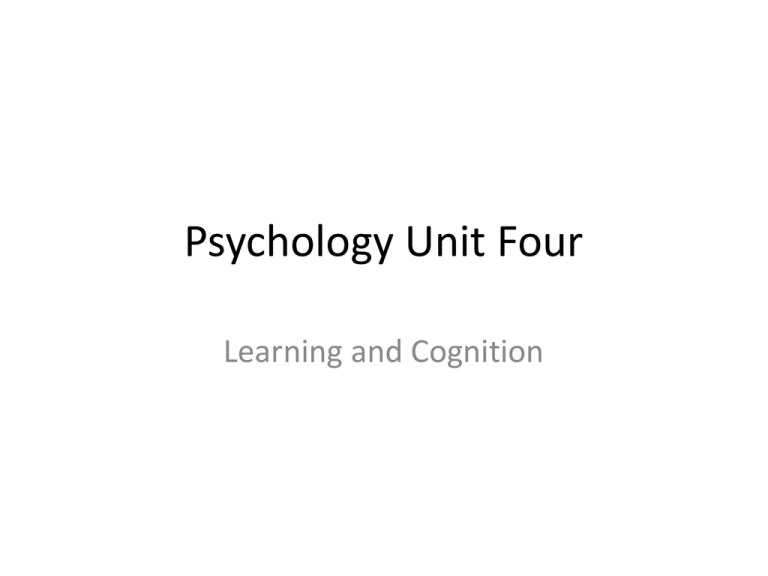
Psychology Unit Four Learning and Cognition Classical Conditioning • Stimulus: anything that produces a reaction from a person or animal – Light, sound, etc. • Response: reaction to a stimulus • Conditioning: learning • Classical conditioning: learning in which one stimulus brings the response of another stimulus – Occurs when stimuli have been associated with each other. – EX: When the school bell rings, you…? Types of stimuli • Unconditioned Stimuli (UCS): stimulus that causes the response that is automatic and not learned • Unconditioned response (UCR): the automatic response itself • Conditioned stimuli (CS): learned stimulus that leads to response • Neutral stimulus: previously unassociated with response • Conditioned response (CR): learned response to stimuli that were previously neutral – Often the same or similar to an unconditioned response Pavlov’s Dogs • Was working to see relationship between nervous system and digestion • Bell ring leads to salivation • Rang bell and then presented with food Adapting to the environment • Taste Aversions: learned avoidance of certain foods – Dislike, illness, bad associations • Extinction: when a conditioned stimulus is no longer followed by an unconditioned stimulus, it will lose its ability to recall conditioned response – Occurs when conditioned stimulus is disconnected from unconditioned stimulus. • Pavlov’s dogs stop salivation when a bell is rang if meet is not produced • Generalization: responding to similar stimuli that are not identical • Discrimination: responding differently to stimuli that are different from one another – Sick of apples? Eat a plum. Applications • Flooding: used to reduce fears – Exposed to the harmless stimulus until fear responses are extinguished • Systematic desensitization: also used to reduce fear – Taught relaxation techniques then gradually exposed to stimulus • Counter Conditioning: pleasant stimuli associated with fear – Given a cookie as viewing fearful rabbit • Bell and Pad method for bed wetting – Noise or vibration when wet – Wakes the child, teaches them to use the bathroom 1. Tamara normally feeds her cat canned cat food. She noticed that every time she uses her electric can opener, her cat comes to the kitchen. What is the conditioned stimulus? A. B. C. D. 2. the car accident Robert's fear and anxiety music by Journey driving in a car Robert developed a conditioned response of fear and anxiety to hearing music by Mozart. If he were to have the same response to any classical music, it would be called A. B. C. D. the cat food the sound of the electric can opener the cat coming to the kitchen Tamara Robert had a serious car accident while Mozart was playing on his stereo. Now, every time Robert hears a Mozart song, he feels frightened and panicked. What is the unconditioned stimulus? A. B. C. D. 3. 4. acquisition. counter conditioning. spontaneous recovery. Generalization. Juan developed a fear of dogs after being attacked by one. His counselor helped him to overcome this fear by teaching him to relax in the presence of dogs. Eventually, he was no longer afraid of dogs. Which of the following processes occurred? A. B. C. D. extinction Systematic desensitization discrimination counter conditioning Operant Conditioning • People and animals learn to do certain things and not others because of the results of what they do. – Learn from consequences of actions – Engage in behavior that results in desirable consequences • Food, an A on a test, social approval – Avoid behaviors that result in negative consequences • Pain or failure • Different from Classical in the fact that voluntary responses have more control of outcomes Rewards and Punishments • Rewards: increase the frequency of a behavior (interchangeable with positive reinforcements) • Punishments: decrease the frequency of a behavior – Doesn’t teach acceptable behavior – Consistency matters – May leave the situation instead of change – Can create anger and hostility Reinforcers • Goal is to continue a behavior • Primary: food, water, warmth (not taught the value) • Secondary: money, attention, approval (learned) 1. Positive reinforcer • Subject gets something they like (reward) • Much more likely to work! • You win the game, you get chocolate, you try to win again next time! 2. Negative reinforcer • Behavior continues by REMOVING something unpleasant • Girlfriend glares at you, you say “sorry”, girlfriend stops glaring Pos vs Neg Reinforcement/Punishment Schedules of Reinforcement • Continuous Reinforcement: occurs every time the behavior occurs. – Maintained only when reinforced • Partial reinforcement: only reward at certain points (not reinforced every time) – Tend to be more long term – Note 4 schedules for partial reinforcement Interval schedules • Reward after certain TIME • Fixed Interval: a fixed amount of time passes between reinforcement time – Rats learned that food was coming at 1 min intervals and began to push lever as the min mark approached • Variable Interval: time varies between reinforcement – Reading quizzes Ratio Schedules • Reward after certain # of responses • Fixed Ratio: reinforcement after a certain number of correct responses – Store punch cards (buy 9, 10th is free) • Variable Ratio: provided after varying correct responses – Slot machines Extinction • Only occurs after repeated performance and no reinforcement Applications • Shaping : applying operant conditioning in “baby steps” – Person gets feedback on small portions of a skill/task – Eventually learns entire action • Programmed Learning: teaching machine – Repeats steps until they are correct – Multiple test taking • Classroom discipline: ignoring bad behavior unless harmful and giving attention to positive behaviors


